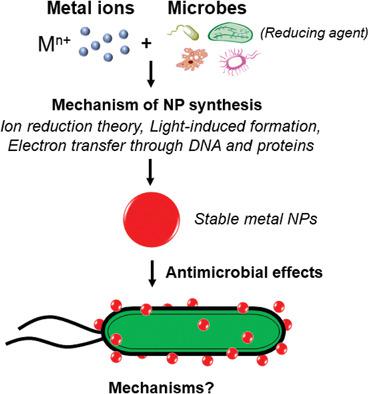当前位置:
X-MOL 学术
›
Part. Part. Syst. Charact.
›
论文详情
Our official English website, www.x-mol.net, welcomes your
feedback! (Note: you will need to create a separate account there.)
Metal Nanoparticle–Microbe Interactions: Synthesis and Antimicrobial Effects
Particle & Particle Systems Characterization ( IF 2.7 ) Pub Date : 2020-03-17 , DOI: 10.1002/ppsc.201900419 Mujeebur R. Khan 1 , Katharina M. Fromm 2 , Tanveer F. Rizvi 1 , Bernd Giese 2 , Faheem Ahamad 1 , Raymond J. Turner 3 , Michael Füeg 4 , Enrico Marsili 5
Particle & Particle Systems Characterization ( IF 2.7 ) Pub Date : 2020-03-17 , DOI: 10.1002/ppsc.201900419 Mujeebur R. Khan 1 , Katharina M. Fromm 2 , Tanveer F. Rizvi 1 , Bernd Giese 2 , Faheem Ahamad 1 , Raymond J. Turner 3 , Michael Füeg 4 , Enrico Marsili 5
Affiliation

|
Metal nanoparticles (NPs), chalcogenides, and carbon quantum dots can be easily synthesized from whole microorganisms (fungi and bacteria) and cell‐free sterile filtered spent medium. The particle size distribution and the biosynthesis time can be somewhat controlled through the biomass/metal solution ratio. The biosynthetic mechanism can be explained through the ion‐reduction theory and UV photoconversion theory. Formation of biosynthetic NPs is part of the detoxification strategy employed by microorganisms, either in planktonic or biofilm form, to reduce the chemical toxicity of metal ions. In fact, most reports on NP biosynthesis show extracellular metal ion reduction. This is important for environmental and industrial applications, particularly in biofilms, as it allows in principle high biosynthetic rates. The antimicrobial and antifungal effect on biosynthetic NPs can be explained in terms of reactive oxygen species and can be enhanced by the capping agents attached to the NP during the biosynthesis process. Industrial applications of NP biosynthesis are still lagging, due to the difficulty of controlling NP size and low titer. Further, the environmental assessment of biosynthetic NPs has not yet been carried out. It is expected that further advancements in biosynthetic NP research will lead to applications, particularly in environmental biotechnology.
中文翻译:

金属纳米粒子与微生物的相互作用:合成和抗菌作用
金属纳米颗粒(NPs),硫族化物和碳量子点可以很容易地从整个微生物(真菌和细菌)和无细胞无菌过滤废培养基中合成。粒度分布和生物合成时间可以通过生物质/金属溶液的比例来控制。可以通过离子还原理论和紫外光转化理论来解释生物合成机理。生物合成NP的形成是浮游生物或生物膜形式的微生物采用的排毒策略的一部分,以降低金属离子的化学毒性。实际上,关于NP生物合成的大多数报道都显示出细胞外金属离子的减少。这对于环境和工业应用特别是在生物膜中非常重要,因为从原则上讲它允许很高的生物合成速率。可以用活性氧来解释对生物合成NP的抗菌和抗真菌作用,并且可以通过在生物合成过程中附着在NP上的封端剂来增强抗菌和抗真菌作用。由于难以控制NP大小和低滴度,NP生物合成的工业应用仍然滞后。此外,尚未进行生物合成NP的环境评估。预计生物合成NP研究的进一步发展将导致其应用,尤其是在环境生物技术中。尚未进行生物合成NP的环境评估。预计生物合成NP研究的进一步发展将导致其应用,尤其是在环境生物技术中。尚未进行生物合成NP的环境评估。预计生物合成NP研究的进一步发展将导致其应用,尤其是在环境生物技术中。
更新日期:2020-03-17
中文翻译:

金属纳米粒子与微生物的相互作用:合成和抗菌作用
金属纳米颗粒(NPs),硫族化物和碳量子点可以很容易地从整个微生物(真菌和细菌)和无细胞无菌过滤废培养基中合成。粒度分布和生物合成时间可以通过生物质/金属溶液的比例来控制。可以通过离子还原理论和紫外光转化理论来解释生物合成机理。生物合成NP的形成是浮游生物或生物膜形式的微生物采用的排毒策略的一部分,以降低金属离子的化学毒性。实际上,关于NP生物合成的大多数报道都显示出细胞外金属离子的减少。这对于环境和工业应用特别是在生物膜中非常重要,因为从原则上讲它允许很高的生物合成速率。可以用活性氧来解释对生物合成NP的抗菌和抗真菌作用,并且可以通过在生物合成过程中附着在NP上的封端剂来增强抗菌和抗真菌作用。由于难以控制NP大小和低滴度,NP生物合成的工业应用仍然滞后。此外,尚未进行生物合成NP的环境评估。预计生物合成NP研究的进一步发展将导致其应用,尤其是在环境生物技术中。尚未进行生物合成NP的环境评估。预计生物合成NP研究的进一步发展将导致其应用,尤其是在环境生物技术中。尚未进行生物合成NP的环境评估。预计生物合成NP研究的进一步发展将导致其应用,尤其是在环境生物技术中。











































 京公网安备 11010802027423号
京公网安备 11010802027423号